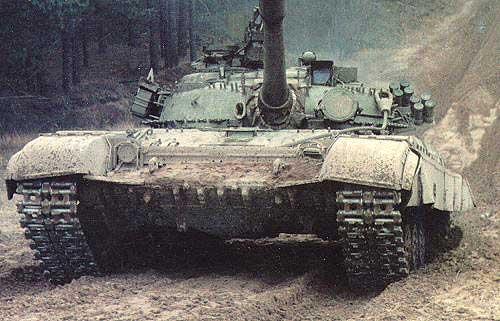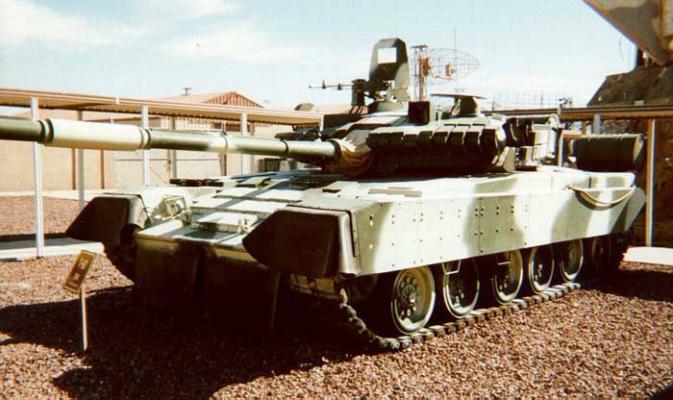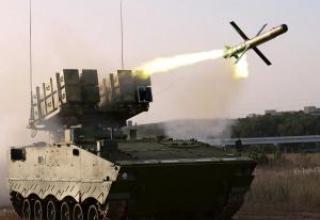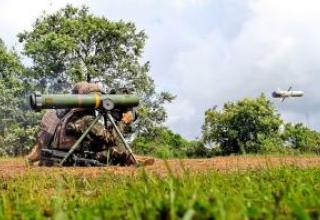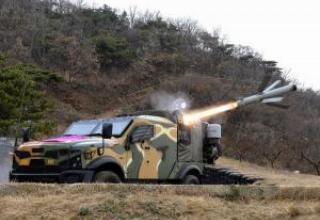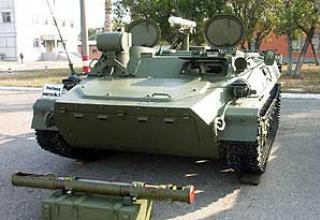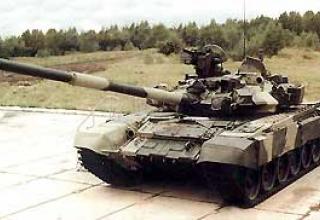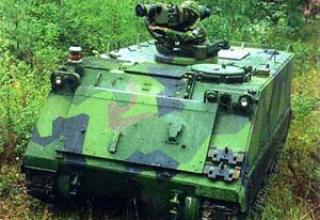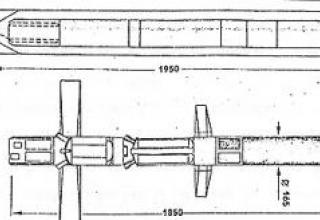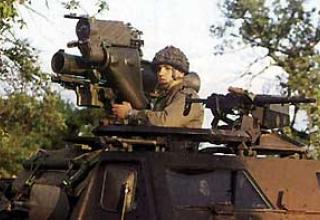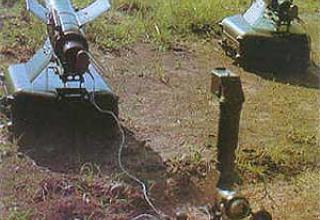The 9K112 Cobra guided weapon system is designed to provide effective firing from a cannon against tanks and other armoured targets of the enemy moving at speeds of up to 75km/hour, as well as for firing against small targets (DOT, DZOT), from place and on the move, at carrier speeds of up to 30km/hour, at ranges of up to 4000m, provided that the target is directly visible through the long-range sight.
In addition to the main purpose 9K112 system has the ability to fire at helicopters at ranges up to 4000m, with target designation at a range of at least 5000m, with a speed of 300km / h, and the height of flight - 500m.
The main developer of the Cobra system is Tochmash Design Bureau (KBTM Moscow).
The Cobra system 9K112 was tested in 1975 at facility 447 (re-equipped T-64A tank) equipped with a 1G21 quantum sights, Cobra missile system with 9M112 missile. The missile was launched from a 2A46 standard cannon. After successful testing in 1976, the upgraded tank under the T-64B index with the 9K112-1 missile system including the 9M112 guided missile was adopted for service. Two years later, the T-80B tank with a gas-turbine engine developed by the Design Bureau of the Leningrad Kirov Plant and equipped with missile system 9K112-1 (missile 9M112M) is put into service. Later on, the Cobra system was used to equip the main T-64BV and T-80BV tanks and some other models of prototype or low-volume vehicles: object 219RD, object 487, object 219A etc.
Since 1976 and up to the present time, the domestic T-64B, T-80B and other tanks have taken precedence over the main foreign models, and they are the only vehicles in the world that carry guided weapons used with conventional guns. This gives our tanks an advantage in the fight against enemy tanks at long ranges, where it is ineffective or inexpedient to use cumulated and sub-calibre projectiles.
By now, the 9K112 Cobra system, although still in service with the Russian Armed Forces, is morally outdated. In the 1980s, the KBM upgraded the 9K112 system under the name Agona using the new 9M128 missile. Based on the results of this work, it was possible to penetrate homogeneous armor up to 650 mm thick. However, by the time the development was completed in 1985 the Svir and Reflex systems with laser beam guidance were already in service, so all newly manufactured T-80 tanks were equipped with these systems.
Its western designation is AT-8 Songster.
Composition:
The 9K112-1 guided weapon complex includes the following elements:
- guided missile 9M112, 9M112M, 9M112M2, 9M124 (see description of 9M112M2/9M124);
- control circuit block 9VZ87;
- tank control equipment 9C461;
- OP-900 converter.
The complex is functionally connected with the fire control system 1AZZ and has a semi-automatic projectile control system using a modulated light source on the projectile and a radio command line. The 9C461 control equipment has five litre frequencies and two control signal codes. Feedback from the projectile to the control equipment on the tank is automatic from a modulated light source (transmitter) installed on board the projectile. To control the missile on the trajectory, the gunner holds the aiming mark on the target and the guidance system automatically leads the missile to it. The missile's coordinates with respect to the sighting line are determined by an optical system using an onboard modulated light source. Control commands are transmitted via a narrowband radio beam.
Based on the requirements for compatibility with the standard armament of the T-64 tank, the 9M112 missile designed for the Cobra system is manufactured in the form of two units - the 9M43 head unit and the 9B447 hardware unit, which are designed in the dimensions of a projectile and a conventional ballistic ammunition charge, and can be placed in any automatic loader tray. When sending the missile at 125 mm smoothbore gun - launcher 2A46-2 (2A46M), both components are automatically docked, and in this form the missile 9M112 departs from the barrel. In order to increase reliability, the designers sought to eliminate the possible connection of electrical networks, which concentrated in the tail unit all the elements of on-board equipment - the receiver of the radio command line, control units and controls. This determined the choice of layout of the missile according to the normal aerodynamic scheme.
The consoles of the four aerodynamic rudders are opened after the rocket leaves the gun barrel. On the tail block are placed and arched rectangular wings in the plan, in the transport position pressed to the missile body and opened by a special device after the launch. The planes of wings and aerodynamic rudders are shifted relative to each other by 45°. A light source and an antenna of radio command equipment are placed on the tail end.
The desire to provide the required length of the head unit has determined the placement of four taper-headed nozzles of solid fuel engine in a "recessed" position in the front of the combustion chamber. The nozzles are located on the same planes as the aerodynamic rudders. Strict dimensional restrictions on placement in the previously created tank automatic charging machine did not allow the application of optimal for supersonic missiles sharpened bypasses - ogival contour of the nose of the rocket starts with a developed spherical dullening.
The complex allows simultaneous firing of guided missiles as a part of a tank company at close targets, including two tanks at one target at an interval between firing tanks at the front of at least 30 meters and the operation of radio lines at various literal frequencies and codes. There are three modes of guidance for the missile:
- In the main mode the missile is launched at an elevation angle of 3°, which practically eliminates the formation of a dust cloud covering the target. After the missile has been captured by a vehicle escort at a distance of up to 100 m from the firing tank, it is brought to the sighting line, which is completed at a distance of up to 900 m. The marching engine runs for 9-10 seconds, after which the guided flight continues until 17 seconds, when the radiation of the tank equipment is automatically stopped. The range of vertical aiming angles for this firing mode is from minus 7° to plus 11° and at rolls up to 15°.
- The second mode (over firing) is used for firing over dusty ground. In the main section of the trajectory, the missile flies with an excess of 3 ... 5m over the target sighting line. Withdrawing to the target trajectory is carried out in the final flight section 1.5...2 s before hitting. This mode is also used for night firing - illumination from the rocket does not prevent the gunner from holding the crosshairs of the sight on the target. When firing in this mode, the gunner must first measure the distance to the target.
- The third (reserve) mode provides for launch at a small angle of elevation - less than 1° and is used to hit targets that suddenly appear in the near zone, at a distance of less than 1 km. In this mode, the missile is lowered to the aiming line after 80-100 meters of flight.
Characteristics:
| Range of fire, m | 100-4000 |
| Average flight speed, m/s | 400 |
| The length of the rocket with the propellant charge, mm | 1000 |
| The length of the rocket in flight, mm | 968 |
| Rocket caliber, mm | 125 |
| Weight in flight (initial without pallet), kg | 24 |
| Weight with pallet and throwing device, kg | 31.1 |
| Armor-piermeable, mm | 600-700 |
| The probability of hitting a tank type target | 0.8 |
| Shooting method | from one place to another |
| Control System | close-range semi-automatic command |
| Type of launcher | gun 2A46-2 |
| Operating Conditions | at an ambient temperature of -40 to +50° C, relative humidity up to 98% at 35°C, altitude up to 3000m |
Testing:
The first combat use of the S-200 SAM system took place in 1982 in Syria, where at a distance of 190 km the E-2C "Hawkeye" DRLO was shot down, after which the American aircraft carrier fleet withdrew from the Lebanese coast. The Libyan S-200 complexes took part in repulsing an attack by American FB-111 bombers and possibly shot down one bomber.
On the basis of the 5B28 anti-aircraft missile of the S-200B complex a hypersonic flying laboratory "Cold" has been created to test hypersonic direct-flow air jet engines. The choice of this missile was based on the fact that the parameters of its flight path were close to those required for flight tests of the Hyper-Sonic Propulsion System. It was also considered important that the missile had been decommissioned and its cost was low. The missile's combat unit was replaced by the head compartments of the GLL "Kholod", which housed the flight control system, a liquid hydrogen tank with displacement system, a hydrogen flow control system with measuring devices and, finally, the experimental HPVRD E-57 of axially symmetric configuration.
Sources:
- Невский Бастион N1-1996, выпуск 1
- Р.Д.Ангельский "Отечественные противотанковые комплексы" -М: ООО "Издательство Астрель", 2002,-192с.
- Противотанковая управляемая ракета 9М112М2(9М124). Техническое описание и инструкция по эксплуатации. Военное издательство МО СССР, М.,1990г.
